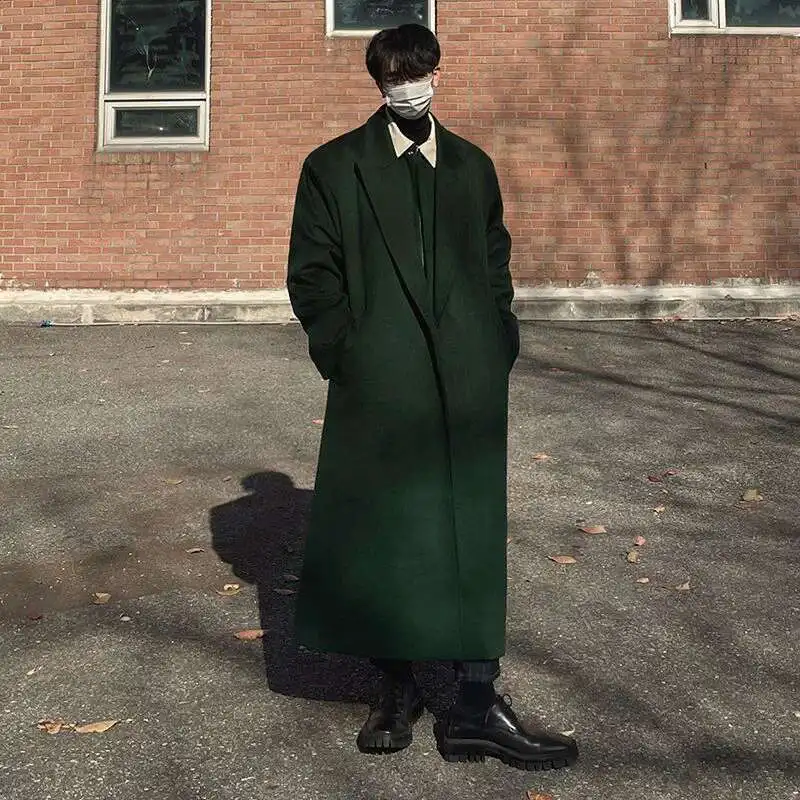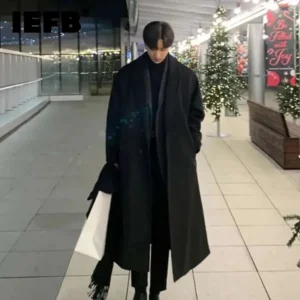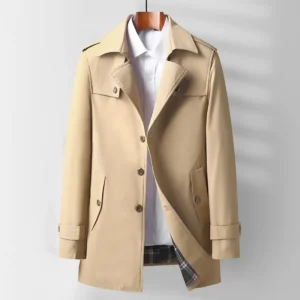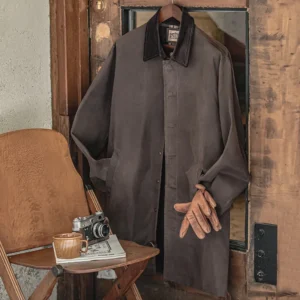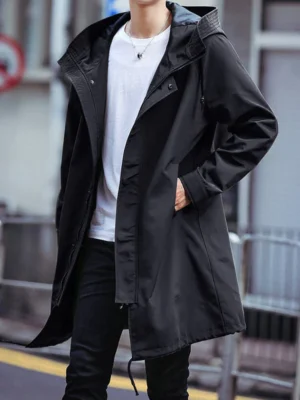Introduction to Essential Winter Layering with Long Overcoats
A long overcoat is the cornerstone of effective winter layering – a garment designed not only to keep you warm but to accommodate multiple clothing layers underneath while maintaining a refined silhouette. The art of winter layering begins with understanding how each piece works together to create a system of warmth, with the overcoat serving as the crowning protective layer.
Winter layering isn’t just about piling on clothes; it’s about strategic combinations that trap heat while allowing moisture to escape. The long overcoat excels in this system by providing extended coverage from shoulders to knees or below, creating a microclimate around your body that shields against harsh elements.
Understanding proper coat length selection is fundamental to maximizing both warmth and style during colder months. A well-chosen long overcoat bridges the gap between functionality and fashion, offering protection in sub-freezing temperatures while elevating your entire winter wardrobe.
Metro Cloak specializes in crafting premium men’s outerwear that strikes this perfect balance between sophistication and functionality. Every element of their overcoats – from material selection to tailored proportions – reflects an understanding that the best winter garments must excel in both form and function.
In this guide, we’ll explore everything you need to know about selecting, styling, and layering with long overcoats to stay warm and stylish all winter long. Finding the perfect winter coat length is essential for both comfort and appearance as temperatures drop.
Why a Long Overcoat is Your Winter Wardrobe Staple
Long overcoats offer unmatched cold-weather advantages that shorter styles simply cannot provide. The extended length creates a significant difference in warmth by protecting your legs from biting winds and low temperatures. This added coverage becomes immediately apparent when temperatures plummet, providing protection for vital areas like the thighs and knees that would otherwise be exposed to the elements.
The enduring appeal of long overcoats stems from their timeless elegance. Unlike many trendy winter garments, a well-crafted long overcoat remains stylistically relevant year after year, making it a true investment piece. This versatility allows you to wear it over everything from formal suits to casual sweaters and jeans.
Key benefits of long overcoats for winter layering include:
- Superior heat retention compared to shorter coats
- More generous interior space to accommodate multiple layers without restriction
- Elegant drape that maintains its shape even with substantial layering underneath
- Protection for a larger portion of the body against wind, snow, and cold
- Timeless silhouette that complements diverse wardrobes and style preferences
A quality long overcoat serves as the perfect finishing layer in any winter outfit strategy. The ample cut provides room for sweaters, vests, or even suit jackets underneath while maintaining a clean exterior line. This makes long overcoats from our men’s long overcoat collection particularly valuable for those who need to transition between indoor and outdoor environments throughout the day.
The investment value of a premium long overcoat cannot be overstated. While the initial cost may be higher than more casual outerwear, the durability, versatility, and timeless appeal make it an economical choice over time. Understanding proper coat length for men helps ensure you select a style that will serve you well for many winters to come.
Key Considerations for Selecting a Long Overcoat for Layering
Material Matters: Warmth, Weight, and Durability
The material of your overcoat determines its warmth, weight, and longevity – three critical factors for effective winter layering. Premium wool varieties stand as the gold standard for winter overcoats, each offering distinct advantages:
Cashmere Wool: Exceptionally soft with outstanding insulation properties, cashmere provides luxurious warmth without heaviness. Though more delicate than other wools, its superior comfort and thermal efficiency make it ideal for moderate winter conditions.
Merino Wool: Finer than standard wool, merino offers excellent temperature regulation and moisture-wicking properties. It’s less likely to cause itching and maintains warmth even when damp – a valuable feature during unpredictable winter weather.
Melton Wool: Dense and tightly woven, melton wool delivers exceptional wind resistance and durability. Its sturdy construction makes it perfect for daily wear in harsh conditions, though it sacrifices some breathability for its protective qualities.
Tweed Wool: This textured fabric combines warmth with distinctive visual character. Its naturally water-resistant properties and durability make it particularly well-suited for damp, cold climates.
Our men’s wool overcoat collection features these premium materials crafted specifically for layering comfort.
For those seeking maximum warmth in extreme conditions, down and synthetic insulation options provide remarkable heat retention. Down insulation offers an unmatched warmth-to-weight ratio but requires careful protection from moisture. Synthetic alternatives like Thinsulate or PrimaLoft maintain their insulating properties even when wet, making them practical choices for variable winter conditions.
Blended materials represent a modern approach to overcoat construction, combining natural fibers with performance synthetics. These hybrids balance tradition with technology, offering enhanced durability and sometimes improved weather resistance while maintaining classic aesthetics.
Many contemporary overcoats incorporate weather-resistant finishes that repel water and block wind without compromising breathability. These treatments add significant functional value, particularly for overcoats in our herringbone pattern collection that combine timeless style with modern performance.
The Art of Fit: Ensuring Comfort and Mobility with Layers
Achieving the perfect fit for a layering overcoat requires careful consideration of how the garment will accommodate additional clothing underneath. The shoulders serve as the foundation of proper fit – they should be wide enough to accommodate a suit jacket or thick sweater without pulling or restriction, yet not so oversized that they create a sloppy appearance.
Key fitting points for layering overcoats include:
- Shoulder fit: Should extend just slightly beyond your natural shoulder to allow room for layers
- Chest measurement: With arms at sides, there should be 4-6 inches of room between your chest and the buttoned coat
- Sleeve length: Should fall at the base of your thumb when arms are at rest, allowing inner layers to show approximately ¼ inch
- Body silhouette: Should follow your natural shape without pulling when buttoned over typical layers
- Movement test: You should be able to comfortably cross your arms and raise them without significant restriction
When trying on overcoats for layering, wear the types of clothing you’ll typically have underneath – a suit jacket, heavy sweater, or both. This “real-world” approach to fitting ensures your coat will perform as needed when temperatures drop.
The ideal balance creates a silhouette that appears intentional rather than bulky. A properly fitted overcoat skims over your layers without clinging or billowing excessively. Remember that different coat styles (slim, classic, relaxed) offer varying degrees of layering capacity, so choose according to your typical winter wardrobe needs.
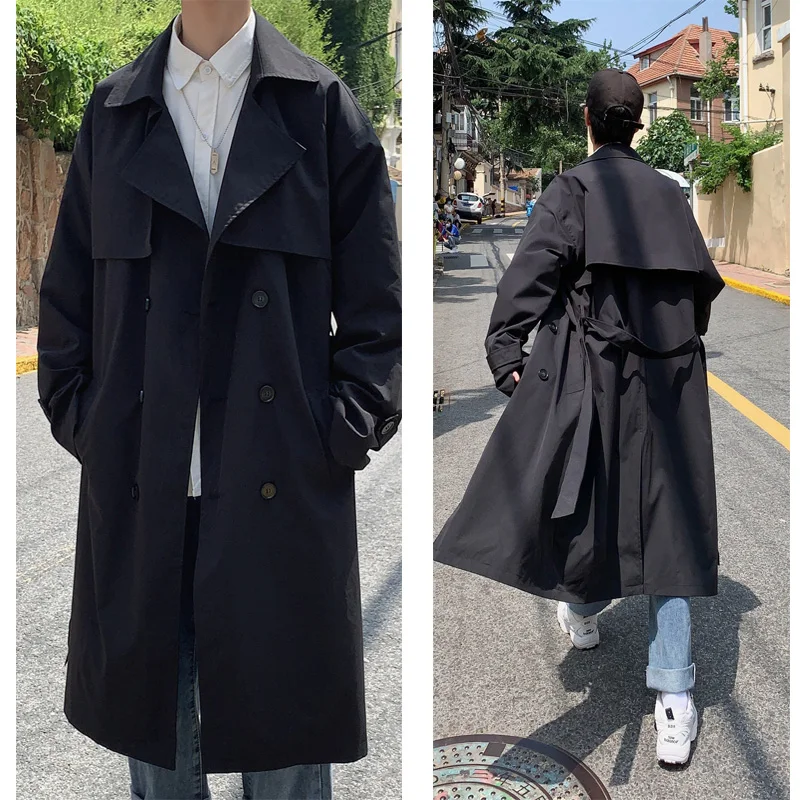
Optimal Length for Winter Protection and Style
The length of your overcoat dramatically impacts both its protective qualities and overall aesthetic. Understanding these differences helps you select the most appropriate style for your needs.
Mid-thigh length (34-36 inches): Offers a modern, versatile silhouette that works well in milder winters or urban environments. This length provides moderate coverage while maintaining maximum mobility. Ideal for those who are shorter in stature or prefer a more contemporary look.
Knee length (38-42 inches): Represents the classic overcoat proportion, delivering substantial coverage while maintaining versatility. This length balances protection and ease of movement, making it the most adaptable choice for varied winter conditions. Works well across most body types and heights.
Below-knee/ankle length (44-50 inches): Provides maximum protection in harsh winter conditions, with dramatic visual impact. This traditional length offers unmatched coverage for the legs and creates a commanding presence. Best suited for taller individuals and extreme cold.
Understanding the differences between short versus long coat styles helps you make informed decisions based on your specific needs and body proportions.
Your climate should significantly influence your length choice – colder environments benefit from longer coats, while milder winters might be better served by shorter options that won’t feel excessive. Similarly, your primary use case matters – commuters spending time on cold public transportation platforms might prioritize length differently than someone primarily moving between heated buildings and vehicles.
The relationship between height and coat length deserves special attention. While rules aren’t absolute, shorter individuals generally benefit from mid-thigh to knee-length options that maintain proportion, while taller people can confidently wear longer styles without being overwhelmed by fabric.
Internal Construction and Features for Enhanced Warmth
The hidden details inside your overcoat often determine its true cold-weather performance. Superior internal construction creates the foundation for effective winter layering.
Lining options significantly impact both comfort and warmth:
– Quilted linings: Provide additional insulation through trapped air pockets
– Insulated linings: Incorporate technical materials like Thinsulate for maximum warmth without bulk
– Traditional satin or silk linings: Offer smooth gliding over inner layers and moderate temperature regulation
– Partial linings: Allow greater breathability while protecting high-friction areas
Collar design plays a crucial role in neck protection and overall warmth:
– Stand-up collars shield the neck from wind when fully fastened
– Notched lapels offer classic styling with the option to “pop” for added protection
– Shawl collars provide elegant draping with excellent neck coverage when turned up
Effective closure systems prevent cold air infiltration:
– Double-breasted styles with overlapping fabric create an additional wind barrier
– Storm flaps cover button or zipper closures to block drafts
– Hidden plackets conceal closures while providing another layer of protection
– Throat latches secure the collar closed in extreme conditions
Thoughtful cuff construction prevents heat loss at the wrists, with options ranging from adjustable closures to knitted internal cuffs. Similarly, well-designed pockets serve both practical and thermal purposes – deep, lined hand pockets provide both storage and hand warming capability.
Style, Aesthetics, and Occasion Versatility
Long overcoats span a range of styles that blend functionality with distinct aesthetic identities. Understanding these classic silhouettes helps you select an option that complements your personal style and wardrobe needs.
The Chesterfield: This refined single-breasted style with a velvet collar represents timeless elegance. Its clean lines and subtle tailoring make it particularly suitable for formal and business settings. Typically found in charcoal, navy, or black, the Chesterfield pairs effortlessly with suits and dress wear.
The Polo Coat: Featuring a belted waist, turned-back cuffs, and patch pockets, this heritage style brings casual sophistication to winter layering. Its camel-colored wool has become iconic, creating a distinctive look that bridges formal and casual contexts.
The Wool Trench: This military-inspired design combines practicality with structure. Its belted waist, storm flaps, and defined shoulders create a sharp silhouette even over multiple layers. Versatile enough for both business and casual settings.
The Duffle Coat: Distinguished by its toggle closures and hood, this casual option offers practical warmth with a relaxed aesthetic. Perfect for casual layering over sweaters and jeans.
Our dress coat collection features elegant options specifically designed for formal occasions and business wear.
When selecting colors, consider both versatility and personal style. Classic neutrals (navy, charcoal, camel, black) offer maximum wardrobe compatibility, while burgundy, forest green, or subtle patterns can make a distinctive statement while remaining sophisticated.
Pattern choices like herringbone, houndstooth, or windowpane add visual interest without sacrificing versatility. These classic patterns have enduring appeal that transcends seasonal trends.
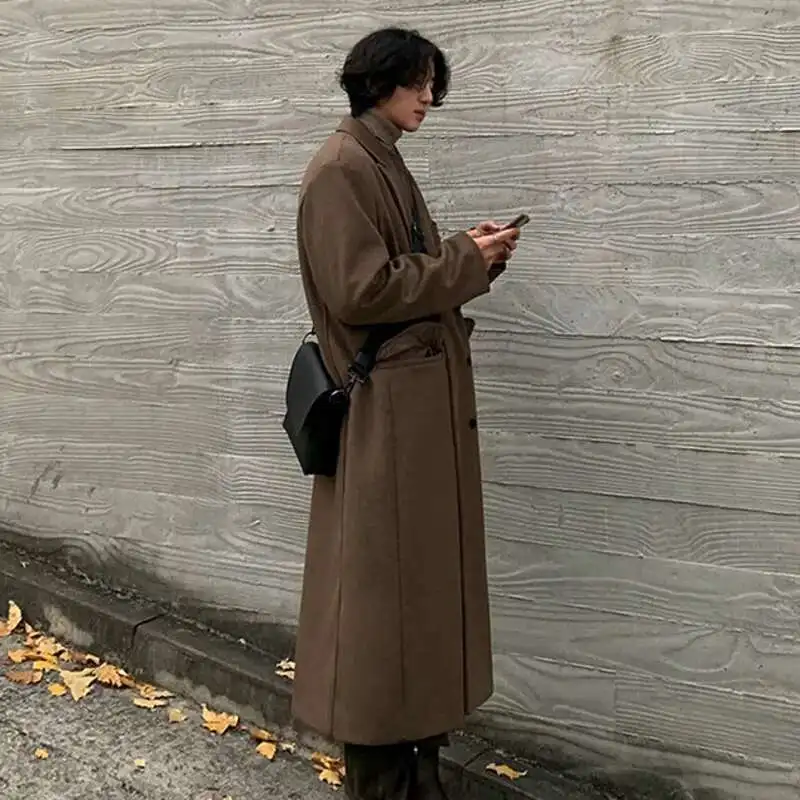
Top Long Overcoat Picks for Men’s Winter Layering
When evaluating premium overcoats for winter layering, certain standout options rise above the rest, combining exceptional materials, construction, and design features that make them ideal outer layers.
Best Overall Performance Overcoat
The ideal all-around performer balances multiple factors – warmth, versatility, and refined styling. Look for a knee-length wool-cashmere blend with a partial quilted lining. This construction provides exceptional insulation while maintaining breathability. A classic single-breasted closure with concealed placket prevents drafts without sacrificing clean lines.
Key features to seek include:
– 80/20 wool-cashmere blend for optimal warmth-to-weight ratio
– Natural shoulder with room for suit jackets or heavy sweaters
– Water-repellent treatment for light precipitation resistance
– Interior wind guards at critical points
This style excels across diverse winter scenarios from business settings to weekend wear, making it the most versatile investment for varied winter needs.
Best for Extreme Cold Conditions
For severe winter environments, specialized construction becomes essential. The premier options in this category often feature longer lengths (below knee) in heavyweight wool (24-28 oz) with additional insulating layers. A fully insulated lining with strategic quilting maximizes warmth without creating excessive bulk.
Distinctive features include:
– Substantial collar that can be raised against wind chill
– Double-breasted closure for overlapping protection
– Insulated storm flap covering the closure system
– Deeper hand warmer pockets with fleece lining
These technical details make this style ideal for commuters in northern climates or anyone regularly facing extended exposure to harsh winter conditions.
Our insulated long coat collection provides excellent options for those facing the most challenging winter conditions.
Most Stylish & Elegant Wool Overcoat
When sophistication is paramount, certain overcoat designs offer exceptional refinement while maintaining practical winter functionality. The most elegant options typically feature a knee-length silhouette in premium 100% wool with meticulous tailoring details. Clean lines and perfect draping create a distinguished profile even when layered over suits.
Notable characteristics include:
– Picked stitching along lapels and pocket flaps
– Hand-finished buttonholes
– Half-canvas construction for structured drape
– Subtle herringbone or bird’s eye pattern
This category represents the pinnacle of overcoat craftsmanship, ideal for professional environments and formal occasions.
Mens Black Overcoat, Mens Black Wool Coat, Mens Wool Overcoat
$339.18 Select options This product has multiple variants. The options may be chosen on the product pageMens Grey Overcoat, Mens Wool Blend Coat, Mens Wool Overcoat
$201.28 Select options This product has multiple variants. The options may be chosen on the product pageMens Herringbone Coat, Mens Long Overcoat, Mens Wool Overcoat
Price range: $197.16 through $203.69 Select options This product has multiple variants. The options may be chosen on the product pageMens Long Overcoat, Mens Topcoats
Price range: $189.40 through $196.88 Select options This product has multiple variants. The options may be chosen on the product pageMens Long Overcoat, Mens Tweed Coat
Price range: $397.49 through $409.96 Select options This product has multiple variants. The options may be chosen on the product pageMens Black Overcoat, Mens Long Overcoat
Price range: $100.12 through $173.24 Select options This product has multiple variants. The options may be chosen on the product page
Best Value Long Overcoat
Value doesn’t mean compromise – the best options in this category deliver impressive performance through thoughtful design choices. Look for a wool-polyester blend (at least 70% wool) that maintains good insulation properties while increasing durability and reducing cost. Smart construction focuses resources where they matter most.
Important elements include:
– Reinforced stitching at stress points
– Durable satin lining
– Clean single-breasted design that won’t look dated
– Classic navy or charcoal color for maximum versatility
These coats represent smart investments that deliver years of reliable performance at a more accessible price point.
Top Sustainable and Ethical Choice
As environmental consciousness grows, outstanding options now combine winter performance with responsible production. The leaders in this category typically feature recycled wool blends or organic wool certified by respected standards organizations. Manufacturing transparency ensures ethical labor practices throughout the production chain.
Distinctive attributes include:
– Natural corozo nut or recycled plastic buttons
– Water-based dyes with reduced environmental impact
– Biodegradable or recycled content linings
– Repairable construction for extended lifespan
These forward-thinking options prove that performance, style, and sustainability can coexist in modern winter outerwear.
Mastering the Art of Winter Layering with Your Long Overcoat
The Foundational 3-Layer System Explained
Effective winter warmth relies on strategic layering, with each component serving a specific purpose in the overall system. Understanding this three-part approach helps you adapt to changing conditions while maintaining comfort.
The Base Layer: Foundation of Comfort
This layer sits against your skin and serves primarily to manage moisture. Effective base layers include:
– Merino wool: Naturally regulates temperature and resists odor
– Technical synthetics: Excellent moisture wicking and quick-drying properties
– Silk: Lightweight insulation with natural temperature regulation
– Avoid cotton as it retains moisture and loses insulating properties when damp
The Mid Layer: Insulation Zone
This critical layer traps body heat while allowing moisture vapor to escape. Options include:
– Wool sweaters: Natural insulation with excellent breathability
– Cashmere: Exceptional warmth-to-weight ratio with luxurious feel
– Fleece: Synthetic option with excellent insulation even when damp
– Down or synthetic vests: Core warmth without bulk in the arms
– Suit jackets or sport coats: Add structure and formality while contributing insulation
The Outer Layer: Your Overcoat
The final defensive barrier against the elements, providing:
– Wind protection to prevent heat loss
– Water resistance to keep inner layers dry
– Additional insulation through material and construction
– Visual completion of your overall appearance
This layering system allows for adjustment based on conditions – removing the overcoat when indoors or adding/removing mid-layers as temperature changes throughout the day. For extreme cold (below 20°F/-6°C), consider doubling mid-layers with both a sweater and vest or light jacket beneath your overcoat.
Tips for Seamless Layering Without Bulk
Creating a refined winter silhouette requires thoughtful layering that adds warmth without unnecessary volume. These strategies help maintain a sleek appearance even with multiple garments.
Choose thin, high-quality insulating fabrics that provide warmth without thickness. Fine merino sweaters deliver impressive heat retention while maintaining a slim profile under your overcoat.
Scale garment sizes appropriately throughout your layering system. Base layers should fit close to the body, while mid-layers need just enough room to avoid restriction. Your overcoat should be sized to accommodate typical layers without excessive roominess.
Pay attention to fabric compatibility between layers. Smoother fabrics slide easily over one another, preventing bunching and binding. Textured materials like cable knits may require more room to prevent a distorted outer silhouette.
Focus on strategic warmth rather than uniform thickness. Core insulation (torso and neck) delivers greater comfort benefit than heavy layers throughout. Consider a medium-weight sweater with a scarf rather than an excessively thick sweater alone.
Maintain proportion and balance in your layered ensemble. Thinner base and mid-layers allow your overcoat to drape more naturally, preserving its intended silhouette. This approach creates a more flattering overall appearance.
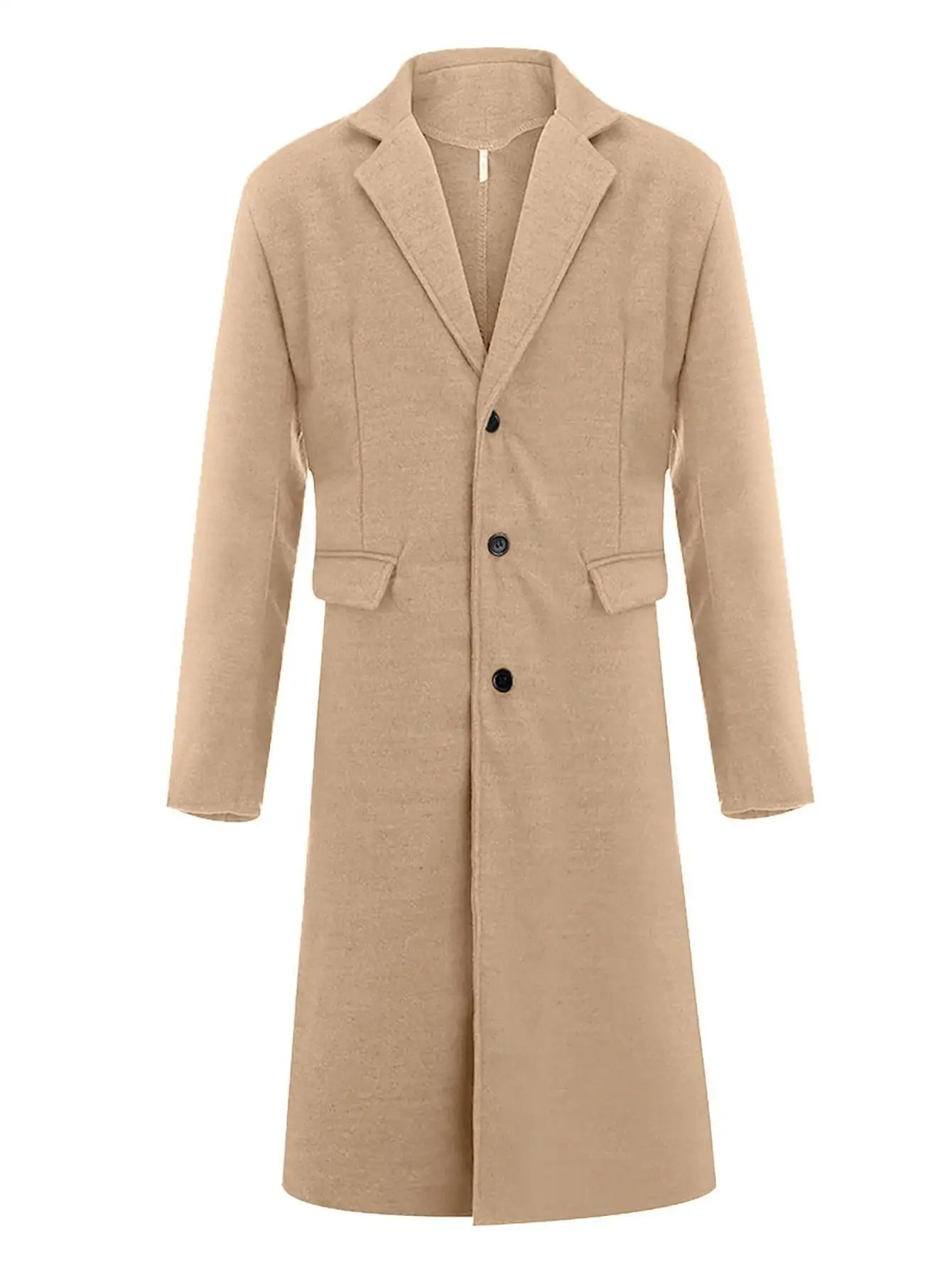
- Coordinate layer lengths for a clean appearance. Each visible layer (shirt, sweater, jacket) should be slightly shorter than the one covering it, creating organized visual harmony rather than a haphazard look.
Mastering these techniques transforms winter layering from a purely functional exercise into a refined expression of personal style. The best winter ensembles balance protection and proportion, keeping you comfortable while maintaining a dignified silhouette. Understanding proper approaches to men’s long winter coats significantly enhances your cold-weather style.
Layering for Different Winter Scenarios
Different winter contexts demand distinct layering strategies that balance warmth, mobility, and appropriate appearance. Adapting your approach to specific scenarios ensures you’re properly protected without being overdressed or underprepared.
Formal Business Settings
When layering for professional environments, focus on refined materials and clean lines:
– Start with a lightweight merino or cotton-blend dress shirt
– Add a fine-gauge sweater or vest in a complementary tone
– Include your suit jacket as a structured mid-layer
– Complete with a knee-length wool overcoat in a classic color
– Enhance neck protection with a silk or cashmere scarf
This approach maintains professional appearance while providing substantial warmth for commuting and outdoor transitions. The layers work together without creating excessive bulk that would distort your silhouette.
Smart Casual Occasions
For versatile everyday elegance, blend comfort with polished style:
– Begin with a quality cotton or blend button-down shirt
– Layer with a merino or cashmere crewneck or quarter-zip sweater
– Add a sports coat or unstructured blazer for additional insulation
– Finish with a three-quarter length overcoat in a versatile neutral
– Incorporate a textured scarf for both warmth and visual interest
This combination offers excellent adaptability for varied indoor and outdoor settings, allowing you to remove layers while maintaining a put-together appearance.
Casual Weekend Wear
For relaxed but stylish cold-weather comfort:
– Start with a henley or lightweight base layer
– Add a flannel shirt or casual button-down
– Layer with a shawl-collar cardigan or casual pullover
– Complete with a more relaxed-fit overcoat or duffle coat
– Include a chunky knit scarf for additional warmth and texture
This approach emphasizes comfort while maintaining a cohesive appearance, perfect for weekend activities and casual social gatherings. The layers provide substantial warmth without the formality of business-oriented combinations.
For all scenarios, consider your transition between environments. Layering works best when you can easily adjust by removing or adding pieces as you move between heated interiors and cold outdoor settings.
Caring for Your Long Overcoat: Maintenance for Longevity
A quality overcoat represents a significant investment that can deliver years of service when properly maintained. Following these care practices ensures your coat remains in excellent condition season after season.
Regular brushing removes surface dirt and prevents particles from embedding in the fabric. Use a soft clothes brush in a downward motion after each wearing, paying special attention to the collar, cuffs, and front closure areas.
Prompt spot cleaning addresses minor stains before they set. Use a clean, damp cloth for water-based spots, and consult a professional for oil-based marks. Avoid rubbing vigorously, which can damage fibers or spread the stain.
Professional cleaning at appropriate intervals preserves fabric integrity. Wool overcoats generally require cleaning only once per season under normal use. Over-cleaning can strip natural oils and accelerate wear.
Proper storage during off-seasons protects shape and prevents pest damage. Use wide, shaped wooden or plastic hangers that support the shoulders properly. Cover with a breathable garment bag – never plastic, which traps moisture and can encourage mildew.
Strategic repairs address minor issues before they worsen. Replace buttons at the first sign of loosening, and have small tears or seam separations repaired immediately by a qualified tailor.
Between wearings, allow your overcoat to rest for 24 hours on a proper hanger, ideally in an open area rather than a crowded closet. This rest period allows the natural fibers to recover and release accumulated moisture. For wool coats, occasional steaming (not direct ironing) refreshes the fabric and removes minor wrinkles.
Can I Layer Multiple Sweaters Under a Long Overcoat?
Yes, you can successfully layer multiple sweaters under a long overcoat, but this approach requires strategic fabric selection and proper coat sizing. The key is choosing thin, high-quality knits rather than bulky options – a fine merino turtleneck paired with a lightweight cashmere crewneck creates substantial warmth without excessive volume. This combination works especially well under overcoats specifically sized to accommodate layering.
To maintain mobility and comfort with multiple mid-layers, focus on pieces that complement rather than compete with each other. A fitted base layer, slightly looser mid-layer, and properly sized overcoat create a graduated system that moves naturally with your body. Remember that proper fit remains essential – even with multiple layers, your overcoat should maintain a clean line without pulling at the shoulders or chest.
How Do I Choose Between a Long Overcoat and a Parka for Winter?
The choice between a long overcoat and a parka depends primarily on your climate, typical activities, and personal style preferences. Long overcoats excel in moderate winter conditions (20°F/-6°C and above) where refined appearance matters. They offer elegant versatility that transitions seamlessly from business to social settings while providing good protection against cold and light precipitation.
Parkas, by contrast, prioritize maximum weather protection in extreme conditions. Their technical fabrics, enhanced insulation, and functional features like hoods and multiple pockets make them superior for very cold environments (below 20°F/-6°C) or situations involving extended outdoor exposure. However, they generally present a more casual appearance that may not suit formal business environments.
For many men, having both options represents the ideal solution – an overcoat for professional and dress occasions, and a parka for casual weekend activities or particularly harsh weather days. If limited to one choice, consider which scenarios dominate your typical winter experience.
What Are the Warmest Materials for Extreme Cold Conditions?
For exceptional cold-weather protection, specific materials stand out for their superior insulating properties:
Cashmere-wool blends (minimum 10% cashmere) provide outstanding warmth with elegant drape and feel. The microscopic air pockets in cashmere fibers create remarkable insulation despite the material’s lightweight nature.
Heavy Melton wool (24-32 oz weight) delivers excellent wind resistance and durable warmth. Its dense weave blocks cold air penetration while maintaining a structured appearance suitable for formal settings.
Down insulation offers the highest warmth-to-weight ratio of any natural material. In puffer-style overcoats, 700+ fill power down provides exceptional protection in the coldest environments while remaining surprisingly lightweight.
Technical synthetic insulation like Thinsulate or PrimaLoft maintains warmth even when damp – a significant advantage in snowy or wet conditions where natural fibers might lose insulating properties.
For extreme conditions, look for overcoats that combine these premium insulating materials with protective design features like high collars, storm flaps, and wind guards at openings. The warmest options often incorporate multiple technologies, such as wool-cashmere shells with strategic synthetic insulation panels.
Is It Better to Size Up for Winter Layering?
Rather than automatically sizing up, focus on finding overcoats specifically designed with layering capacity in mind. Quality winter overcoats already incorporate additional room in the chest, shoulders, and sleeves to accommodate typical cold-weather layers without requiring a size increase. Sizing up often results in disproportionate fit issues – too-long sleeves, dropped shoulders, or excessive length – that compromise both appearance and function.
When shopping, try on overcoats wearing what you would typically layer underneath, whether that’s a suit jacket, heavy sweater, or both. The coat should button comfortably with these layers while maintaining a clean shoulder line and appropriate sleeve length. If you’re between sizes, the larger option may be preferable, but a dramatic size increase is rarely necessary with well-designed winter outerwear.
Remember that different overcoat styles naturally offer varying degrees of layering capacity. Classic full-cut styles like the polo coat provide more room than trimmer modern cuts. Choose a style that aligns with both your layering needs and preferred aesthetic.

